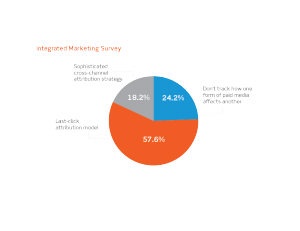The well-embraced and laughingly accepted assessment of marketing made by John Wanamaker “Half the money I spend on advertising is wasted; the trouble is I don't know which half” was thought to be silenced once and for all with the advent and subsequent embrace of digital media in the 1990’s. Digital media promised to dramatically clarify which marketing dollars ended up as an expense, and which as an investment, because tracking was inherent in its DNA. That was years ago. Today, marketing is marketing, be it traditional or digital. And, while there have definitely been advancements in how marketers can track the interactions with one’s brand, what’s more important when seemingly infinite things can be tracked is the value of those interactions. Marketing’s solution: attribution.
Establishing the Value of Marketing Methods
With attribution, as opposed to looking at one-dimensional metrics such as first or last click, marketers look at a broader landscape to form an understanding of how different aspects of their marketing investment interact with one another. In the most simplistic of scenarios, consider the roles of introducer, influencer, and closer. In one customer’s journey to buy a product, content in an online publication could serve the role of introducer and generate a visit to the company’s web site. Advertisements and subsequent user visits, driven by the fact that the visitor signed up for monthly emails, could serve the role of influencer. Finally, a re-targeting ad could serve the role of closer. Of course, there can be - and almost always are - many mutations where different channels and tactics play all three roles of introducer, influencer, and closer; however, when looked at from an arm’s length in aggregate, the data starts to paint a picture of how marketing investments participate in the customer journey.
Multi-Channel Attribution: Everybody’s Doing it, Right?
Multi-Channel Attribution isn’t the latest idea to come out of a Silicon Valley think tank. We’ve had it for a while. There are even low-to-no-cost ways to leverage attribution, such as Google Analytics’ multi-channel funnels. So it’s somewhat surprising that, for the most part, marketers are relying on one-dimensional views and crediting the last touch point (the closer) with the entire conversion.
In the Ignition One Integrated Marketing Survey last year, marketers were asked to share how their organization treated attribution. 57.6% of respondents stated that they used the last-click attribution model. 18.2% indicated that they had a sophisticated cross-channel attribution strategy in place. The remaining 24.2% indicated that they don’t track how one form of paid media affects another. Those statistics leave a lot of room for improvement.
Managing Marketing Investments
One of the clearest problems this causes is a blind spot in the effectiveness of different marketing channels and methods. Considering the simple case above, imagine a significant trend existed where email marketing was driving a great deal of influence along the path to purchase, but it wasn’t known or quantified in any way. Instead, the re-targeting ads, the last click, were deemed to be the secret to success. Budgets might shift, email could get less attention, and optimization and re-marketing dollars could increase. That may or may not have a positive effect on the bottom line, but one thing is for certain: ignorance definitely doesn’t help clear decision-making. If tested out, that theoretical brand could find the right balance of investing in all of the channels they’d committed to and find ways to continually move toward better return-on-investment (ROI).
Last Decade, Last Click
Undoubtedly there are challenges CMO’s and VP’s of Marketing are facing to enjoy the rich data multi-attribution promises. Marketing departments around the globe are challenged by functions operating in silos. Add the complexity of getting leadership, marketing, and technical functions in the company to align and agree upon which investments are important for the company as a whole, and road blocks quickly come to mind.
But for organizations that are willing to roll up their sleeves, it can be done. It should be done. Leave last-click-only attribution behind, where it belongs, and bring the simple sophistication of multi-attribution into your marketing arsenal.





